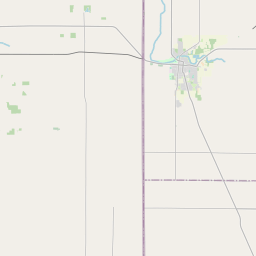Indian Boundary Line
Historical marker location:
Ridgeville, Indiana
( Marker is at the intersection of Treaty Line Road and U.S. 27, on the left when traveling east on Treaty Line Road.)













© OpenStreetMap contributors
The first professional baseball game in the United States was played in Indiana on May 4, 1871. The game was played in Fort Wayne between the Cleveland Forest Citys and the Fort Wayne Kekiongas.
About Randolph County
Randolph County Timeline
Randolph County, Indiana has a rich and diverse history that dates back centuries. The area was originally inhabited by Native American tribes, including the Miami and Delaware, who established hunting grounds and villages along the White River. In the late 18th century, European settlers began to arrive, with the first permanent settlement being established in 1815 by a group of Quakers.
During the early 19th century, Randolph County became a significant center for the Quaker religion and a hub of abolitionist activity. The Quakers played a crucial role in the Underground Railroad, providing safe houses to runaway slaves and helping them escape to freedom in the North. The county was also a stronghold of the anti-slavery movement, and several important abolitionist leaders, including Levi Coffin and Jonathan Lindley, resided there.
The mid-19th century witnessed rapid growth and development in Randolph County. The completion of the Whitewater Canal in the 1840s connected the county with the national transportation network, stimulating economic growth and bringing new opportunities for trade and commerce. The arrival of the railroad in the 1850s further accelerated the county's progress, supporting the establishment of numerous towns and industrial centers.
In the early 20th century, Randolph County faced challenges due to economic downturns and the decline of its industrial base. However, the community persevered and diversified its economy by embracing agriculture, manufacturing, and tourism. Today, Randolph County remains a vibrant and close-knit community, preserving its historical heritage while also embracing modern advancements and opportunities for growth.
During the early 19th century, Randolph County became a significant center for the Quaker religion and a hub of abolitionist activity. The Quakers played a crucial role in the Underground Railroad, providing safe houses to runaway slaves and helping them escape to freedom in the North. The county was also a stronghold of the anti-slavery movement, and several important abolitionist leaders, including Levi Coffin and Jonathan Lindley, resided there.
The mid-19th century witnessed rapid growth and development in Randolph County. The completion of the Whitewater Canal in the 1840s connected the county with the national transportation network, stimulating economic growth and bringing new opportunities for trade and commerce. The arrival of the railroad in the 1850s further accelerated the county's progress, supporting the establishment of numerous towns and industrial centers.
In the early 20th century, Randolph County faced challenges due to economic downturns and the decline of its industrial base. However, the community persevered and diversified its economy by embracing agriculture, manufacturing, and tourism. Today, Randolph County remains a vibrant and close-knit community, preserving its historical heritage while also embracing modern advancements and opportunities for growth.
Randolph County Timeline
This timeline provides a concise overview of the key events in the history of Randolph County, Indiana.
- 1805 - Randolph County is established in the Indiana Territory.
- 1818 - Winchester becomes the county seat of Randolph County.
- 1830s - The construction of the Whitewater Canal spurs economic and population growth in the county.
- 1859 - Noted abolitionist and women's rights advocate, Levi Coffin, settles in the county.
- 1862 - The Civil War impacts the county, with many residents serving in the Union Army.
- 1890s - Natural gas discoveries lead to the establishment of several gas and oil companies in the county.
- 1926 - The county courthouse is destroyed by a fire and is later rebuilt.
- 1952 - Interstate 70 is completed, providing improved transportation access to the county.
- 1990s - The county experiences industrial growth with the establishment of manufacturing facilities.
- Present - Randolph County continues to be a predominantly rural area with a rich agricultural heritage.